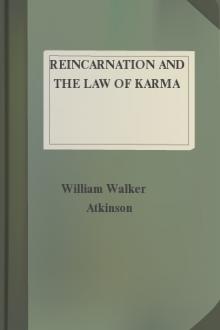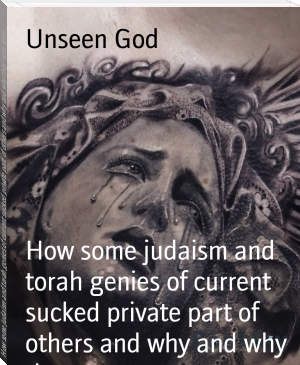Reincarnation and the Law of Karma by William Walker Atkinson (the best ebook reader for android txt) 📖

- Author: William Walker Atkinson
- Performer: -
Book online «Reincarnation and the Law of Karma by William Walker Atkinson (the best ebook reader for android txt) 📖». Author William Walker Atkinson
The Neo-Platonists, who followed Plato, and who adapted his teachings to their many conflicting ideas, held firmly to the doctrine of Reincarnation. The writings of Plotinus, Porphyry, and the other Mystics, had much to say on this subject, and the teaching was much refined under their influence. The Jewish philosophers were affected by the influence of the Platonic thought, and the school of the Essenes, which held firmly to the idea of Rebirth, was a source from which Christianity received much of its early influence.
CHAPTER IV.The early Jewish people had an Inner Teaching which embraced certain ideas concerning Reincarnation, although the masses of the people knew nothing of the doctrine which was reserved for the inner circles of the few. There is much dispute concerning the early beliefs of the Jewish people regarding the immortality of the soul. The best authorities seem to agree that the early beliefs were very crude and indefinite, consisting principally of a general belief that after death the souls are gathered up together in a dark place, called Sheol, where they dwell in an unconscious sleep. It will be noted that the earlier books in the Old Testament have very little to say on this subject. Gradually, however, there may be noticed a dawning belief in certain states of the departed souls, and in this the Jews were undoubtedly influenced by the conceptions of the people of other lands with whom they came in contact. The sojourn in Egypt must have exerted an important influence on them, particularly the educated thinkers of the race, of which, however, there were but few, owing to the condition in which they were kept as bondsmen of the Egyptians. Moses, however, owing to his education and training among the Egyptian priests, must have been fully initiated in the Mysteries of that land, and the Jewish legends would indicate that he formed an Inner Circle of the priesthood of his people, after they escaped from Egypt, and doubtless instructed them fully in the occult doctrines, which, however, were too advanced and complicated for preaching to the mass of ignorant people of which the Jewish race of that time was composed. The lamp of learning among the Jews of that time was kept alight but by very few priests among them. There has always been much talk, and legend, concerning this Inner Teaching among the Jews. The Jewish Rabbis have had so much to say regarding it, and some of the Early Fathers of the Christian Church were of the opinion that such Secret Doctrine existed.
Scholars have noted that in important passages in the Jewish Bible, three distinct terms are used in referring to the immaterial part, or "soul," of man. These terms are "Nichema," "Rouach," and "Nephesh," respectively, and have been translated as "soul," "spirit" or "breath," in several senses of these terms. Many good authorities have held that these three terms did not apply to one conception, but that on the contrary they referred to three distinct elements of the soul, akin to the conceptions of the Egyptians and other early peoples, who held to the trinity of the soul, as we have shown a little further back. Some Hebrew scholars hold that "Nichema" is the Ego, or Intelligent Spirit; "Rouach," the lower vehicle of the Ego; and "Nephesh," the Vital Force, Vitality, or Life.
Students of the Kaballah, or Secret Writings of the Jews, find therein many references to the complex nature of the soul, and its future states, as well as undoubted teachings regarding Reincarnation, or Future Existence in the Body. The Kaballah was the book of the Jewish Mysteries, and was largely symbolical, so that to those unacquainted with the symbols employed, it read as if lacking sense or meaning. But those having the key, were able to read therefrom many bits of hidden doctrine. The Kaballah is said to be veiled in seven coverings—that is, its symbology is sevenfold, so that none but those having the inner keys may know the full truth contained therein, although even the first key will unlock many doors. The Zohar, another Secret Book of the Jews, although of much later origin than the Kaballah, also contains much of the Inner Teachings concerning the destiny of the soul. This book plainly recognizes and states the three-fold nature of the soul, above mentioned, and treats the Nichema, Rouach and Nephesh as distinct elements thereof. It also teaches that when the soul leaves the body it goes through a long and tedious purifying process, whereby the effect of its vices is worn off by means of a series of transmigrations and reincarnations, wherein it develops several perfections, etc. This idea of attaining perfection through repeated rebirths, instead of the rebirths being in the nature of punishment as taught by Plato, is also taught in the Kaballah, showing the agreement of the Jewish mind on this detail of the doctrine. The essence of the Kaballic teaching on this subject is that the souls undergo repeated rebirth, after long intervals of rest and purification, in entire forgetfulness of their previous existences, and for the purpose of advancement, unfoldment, purification, development, and attainment. The Zohar follows up this teaching strictly, although with amplifications. The following quotation from the Zohar is interesting, inasmuch as it shows the teaching on the subject in a few words. It reads as follows: "All souls are subject to the trials of transmigration; and men do not know which are the ways of the Most High in their regard. They do not know how many transformations and mysterious trials they must undergo; how many souls and spirits come to this world without returning to the palace of the divine king. The souls must re-enter the absolute substance whence they have emerged. But to accomplish this end they must develop all the perfections; the germ of which is planted in them; and if they have not fulfilled this condition during one life, they must commence another, a third, and so on, until they have acquired the condition which fits them for reunion with God."
The mystic sect which sprung up among the Jewish people during the century preceding the birth of Christ, and which was in the height of its influence at the time of the Birth—the sect, cult, or order of The Essenes—was an important influence in the direction of spreading the truths of Reincarnation among the Jewish people. This order combined the earlier Egyptian Mysteries with the Mystic Doctrine of Pythagoras and the philosophy of Plato. It was closely connected with the Jewish Therapeutæ of Egypt, and was the leading mystic order of the time. Josephus, the eminent Jewish historian, writing of the Essenes, says: "The opinion obtains among them that bodies indeed are corrupted, and the matter of them not permanent, but that souls continue exempt from death forever; and that emanating from the most subtle ether they are unfolded in bodies as prisons to which they are drawn by some natural spell. But when loosed from the bonds of flesh, as if released from a long captivity, they rejoice and are borne upward." In the New International Encyclopedia (vol. vii, page 217) will be found an instructive article on "Essenes," in which it is stated that among the Essenes there was a certain "view entertained regarding the origin, present state, and future destiny of the soul, which was held to be pre-existent, being entrapped in the body as a prison," etc. And in the same article the following statement occurs: "It is an interesting question as to how much Christianity owes to Essenism. It would seem that there was room for definite contact between John the Baptist and this Brotherhood. His time of preparation was spent in the wilderness near the Dead Sea; his preaching of righteousness toward God, and justice toward one's fellow men, was in agreement with Essenism; while his insistence upon Baptism was in accordance with the Essenic emphasis on lustrations." In this very conservative statement is shown the intimate connection between the Essenes and Early Christianity, through John the Baptist. Some hold that Jesus had a still closer relationship to the Essenes and allied mystic orders, but we shall not insist upon this point, as it lies outside of the ordinary channels of historical information. There is no doubt, however, that the Essenes, who had such a strong influence on the early Christian Church, were closely allied to other mystic organizations with whom they agreed in fundamental doctrines, notably that of Reincarnation. And so we have brought the story down to the early Christian Church, at which point we will continue it. We have left the phase of the subject which pertains to India for separate consideration, for in India the doctrine has had its principal home in all ages, and the subject in that phase requires special treatment.
That there was an Inner Doctrine in the early Christian Church seems to be well established, and that a part of that doctrine consisted in a teaching of Pre-existence of the Soul and some form of Rebirth or Reincarnation seems quite reasonable to those who have made a study of the subject. There is a constant reference to the "Mysteries" and "Inner Teachings" throughout the Epistles, particularly those of Paul, and the writings of the Early Christian Fathers are filled with references to the Secret Doctrines. In the earlier centuries of the Christian Era frequent references are found to have been made to "The Mysteries of Jesus," and that there was an Inner Circle of advanced Christians devoted to mysticism and little known doctrines there can be no doubt. Celsus attacked the early church, alleging that it was a secret organization which taught the Truth to the select few, while it passed on to the multitude only the crumbs of half-truth, and popular teachings veiling the Truth. Origen, a pupil of St. Clement, answered Celsus, stating that while it was true that there were Inner Teachings in the Christian Church, that were not revealed to the populace, still the Church in following that practice was but adhering to the established custom of all philosophies and religions, which gave the esoteric truths only to those who were ready to receive them, at the same time giving to the general mass of followers the exoteric or outer teachings, which were all they could understand or assimilate. Among other things, in this reply, Origen says: "That there should be certain doctrines, not made known to the multitude, which are divulged after the exoteric ones have been taught, is not a peculiarity of Christianity alone, but also of philosophic systems in which certain truths are exoteric and others esoteric. Some of the followers of Pythagoras were content with his 'ipse dixit,' while others were taught in secret those doctrines which were not deemed fit to be communicated to profane and insufficiently prepared ears. Moreover, all the mysteries that are celebrated everywhere through Greece and barbarous countries, although held in secret, have no discredit thrown upon them, so that it is in vain he endeavors to calumniate the secret doctrines of Christianity, seeing that he does not correctly understand its nature." In this quotation





Comments (0)